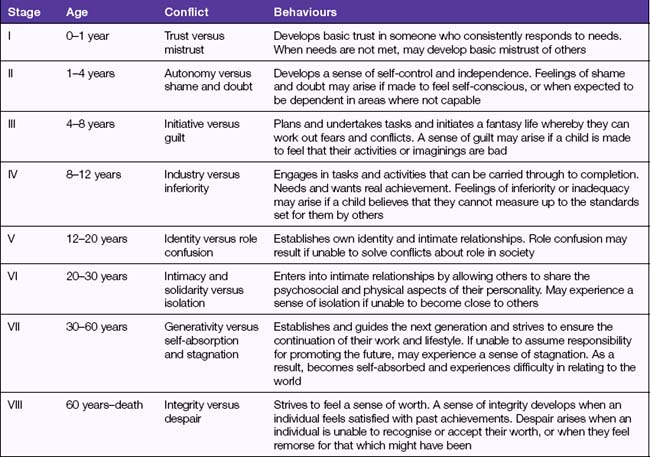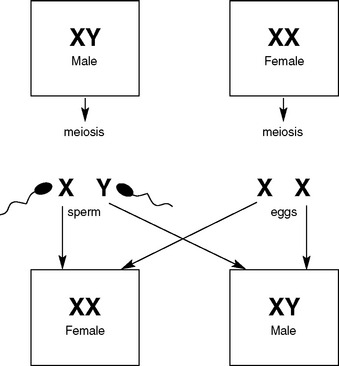Chapter 15 THEORIES OF GROWTH AND DEVELOPMENT: CONCEPTION THROUGH TO LATE CHILDHOOD
THEORIES OF DEVELOPMENT
Some theories view development as a continuous process that moves from the simple to the complex, while other theories view development as a process characterised by alternating periods of equilibrium and change. The various developmental theories differ in how the human being is viewed. The following section of this chapter provides the reader with an introduction to the major theories, or approaches, which are psychoanalytical, cognitive–developmental, maturational, social learning and moral. It is not the intent of this section to provide the reader with an in-depth analysis of these theories, rather to provide an overview of each approach. It is expected that the reader will consult further texts, such as Sigelman (2003) if more information is required.
FREUD’S THEORY
According to Freud, an individual’s personality is composed of the ‘id’, the ‘ego’ and the ‘superego’ (Sigelman 2003). The id is that part of the psyche that is the source of instinctive energy, impulses and drives. Based on the pleasure principle, it directs behaviour towards self-gratification. The ego represents the conscious self and is that part of the psyche that maintains conscious contact with reality and tempers the primitive drives of the id and the demands of the superego with the physical and social needs of society. The superego is the individual’s conscience, which is formed as the result of internalisation of societal demands and restrictions (Carel 2006).
Freud’s theory of development is based on a series of psychosexual stages through which a person must pass. Successful completion of each stage is necessary before the next stage can be entered without detrimental effects on future development. According to Freud, specific body areas are the primary sites for expression and achievement of needs, and these sites change from stage to stage. Table 15.1 outlines the stages of development according to Freud’s theory.
TABLE 15.1 Developmental stages according to Freud
| Stage | Age | Behaviours |
|---|---|---|
| Oral | 0–18 months | |
| Anal | 1–3 years | |
| Phallic | 3–6 years | |
| Latency | 6–12 years | |
| Genital | 12 years–adult |
ERIKSON’S THEORY
Using the psychoanalytical framework, Erik Erikson based his (1963) theory of development on the process of socialisation. He describes another series of stages of personal and social development as the ‘eight ages of man’, and views development as a continuous struggle for an emotional–social balance (Sugarman 2001).
According to Erikson, a person spends his whole life constructing, shaping and reshaping his personality, which is influenced by psychological, biological, social and environmental factors. Erikson identifies core problems that the individual tries to master during each stage of personality development. Progression to the next stage depends on resolution of the problem; however, no core problem is ever entirely resolved, as each new situation will present a conflict in a new form. Table 15.2 outlines the stages of development according to Erikson.
PIAGET’S THEORY
Jean Piaget’s (1952) theory of cognitive development, which deals only with cognition and does not take into account all psychosocial aspects of the personality, views development as gradual, progressive and related to age. Piaget’s views are that, for learning to occur, a variety of new experiences or stimuli must exist. He believed that there are four major stages in the development of logical thinking, and that each stage builds on the accomplishments of the previous stage. Table 15.3 outlines Piaget’s stages of cognitive development (Huitt & Hummel 2003).
TABLE 15.3 Piaget’s stages of cognitive development
| Stage | Age | Intellectual development |
|---|---|---|
| Sensorimotor | Birth–2 years | This stage of intellectual development is governed by sensations in which simple learning takes place. Problem solving is primarily trial and error, as the child progresses from reflex activity, through repetitive behaviours, to imitative behaviour. The child gradually acquires a sense that external objects have a separate and independent existence and that they exist even when they are not visible to them |
| Preoperational | 2–7 years | During this stage the predominant characteristic is egocentricity, wherein the child considers their own viewpoint as the only one possible. Thinking is concrete and tangible and the child lacks the ability to make deductions or generalisations. Problem solving does not usually follow logical thought processes |
| Concrete operational | 7–11 years | Thought becomes increasingly logical, and problems are solved in a systematic fashion. The child is able to consider points of view other than their own. Towards the end of this stage, the child demonstrates a greater reasoning ability |
| Formal operational | >11 years | Thinking is characterised by logical reasoning. The adolescent is able to think in abstract terms, draw logical conclusions and solve problems |
GROWTH AND DEVELOPMENT
Growth and development are interrelated processes that are influenced by a variety of factors. The theoretical approaches outlined in this chapter, together with various other approaches, provide a framework for understanding the complexities of growth and development. Each approach emphasises different aspects of development; for example, cognitive developmentalists concentrate primarily on intellectual development, psychoanalytical theorists emphasise social and personality development, while maturational theorists focus primarily on physical growth and development (Santrock 2007).
Growth and development occur in specific directions. Development is closely related to maturation of the nervous system, and occurs in the cephalocaudal direction (head to tail), which is logical; for example, motor control must be established in the brain before the neuromuscular connections required by leg and back muscles for walking develop. The second direction is from the centre of the body outwards (proximodistal); for example, infants learn to control shoulder movements before they control hand movements (Santrock 2007).
There is a sequence, order and pattern to growth and development. There are certain developmental tasks that must be accomplished during each stage. A developmental task is a set of skills and competencies specific to each developmental stage, which children must accomplish to deal effectively with their environment. Each stage lays the foundation for the next stage of development. The stages of development are:
CONCEPTION
Conception, formally defined as the union of a single egg and sperm (gametes), is the benchmark of the beginning of a pregnancy. This event does not occur in isolation but as a result of a series of events, including ovulation (release of the egg), union of the gametes and implantation of the embryo into the uterus. Only after all these events are successfully completed can the process of embryonic and fetal development begin (Figure 15.1 and Table 15.4).
| Term | Time period in fetal development |
|---|---|
| Ovum | From ovulation to conception (fertilisation) |
| Zygote | From conception (fertilisation) to implantation |
| Embryo | From implantation to 8 weeks after conception |
| Fetus | From 8 weeks after conception until term |
Implantation (embedding in the endometrium) occurs about 10 days after fertilisation and normally occurs in the upper body of the uterus. After implantation, the lining of the uterus grows over the blastocyst and pregnancy is established. From this stage onwards the lining of the uterus is termed the decidua (Marieb 2004).
The inner cell mass of the blastocyst differentiates into three distinct layers:
The embryo continues to develop until by the end of the 2nd month it resembles a human, and is called a fetus. From this stage onwards the major activities are growth and organ specialisation. By the end of 40 weeks the fetus is about 50 cm long and weighs between 2.7 and 4.1 kg (Table 15.5).
TABLE 15.5 Embryonic and fetal growth and development
| Zygote (5 weeks) | Complete sac 1 cm in diameter covered with chorionic villi. No recognisable human characteristics |
| Embryo (6 weeks) | Sac 2–3 cm in diameter, weight 1 g. Head enlarges, arm and leg buds forming, primitive heart beginning to function, circulation in primitive form, connections made between vessels in chorion |
| 10 weeks | Embryo 4 cm long. External genitals appear, anal membrane breaks down, hands and feet recognisable, human form apparent |
| Fetus (12 weeks) | Fetus 8 cm long, weight 15 g. Fingers and toes, eyes and ears, circulation and kidneys developed, nasal septum and palate have fused, endocrine glands and nervous system begin to function |
| 16 weeks | Fetus 16 cm long, weight 110 g. Sex easily identifiable, fingernails visible, good heartbeat, fetal movements felt. Basic development complete — the fetus now has to mature |
| 20 weeks | Length 22 cm, weight 300 g. Vernix on skin, lanugo (fine hair) on body, eyebrows, fetus now legally viable |
| 24 weeks | Length 30 cm, weight 600 g. Wrinkled skin, fat deposited, brain development continues |
| 28 weeks | Length 35 cm, weight 1000 g |
| 32 weeks | Length 42 cm, weight 1700 g. Skin red, wrinkled |
| 36 weeks | Length 46 cm, weight 2500 g. Nails reach fingertips |
| 40 weeks | Length 50 cm, weight 3400 g. Baby well covered with fat, skin red, not wrinkled, all organs functioning with the exception of the lungs |
(modified from Bobak & Jensen 1993)
Stay updated, free articles. Join our Telegram channel

Full access? Get Clinical Tree




